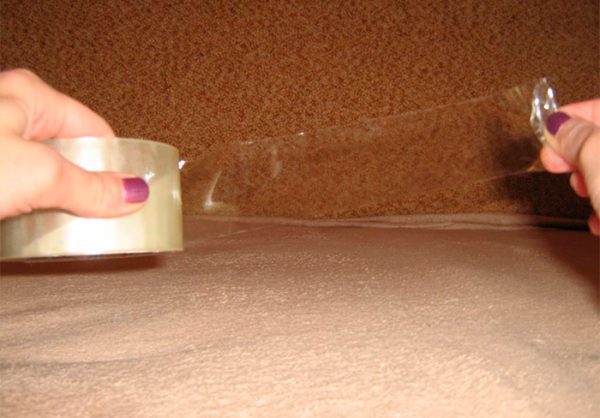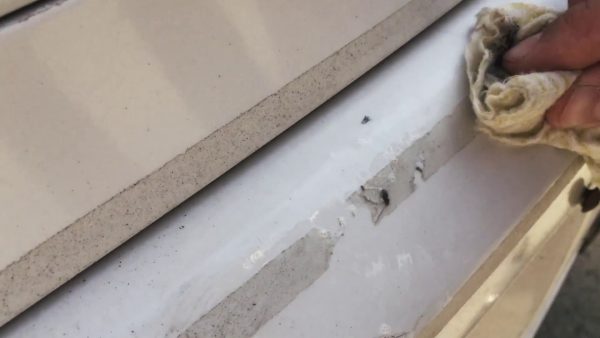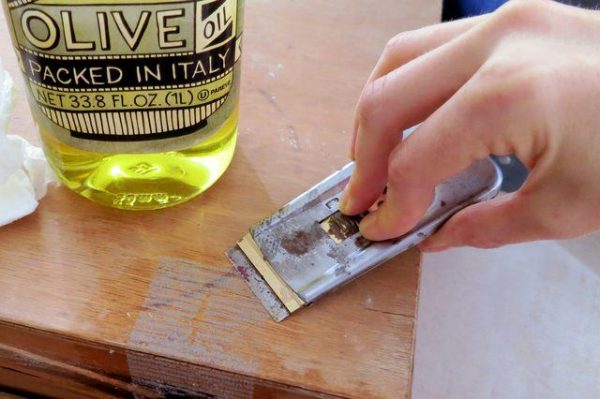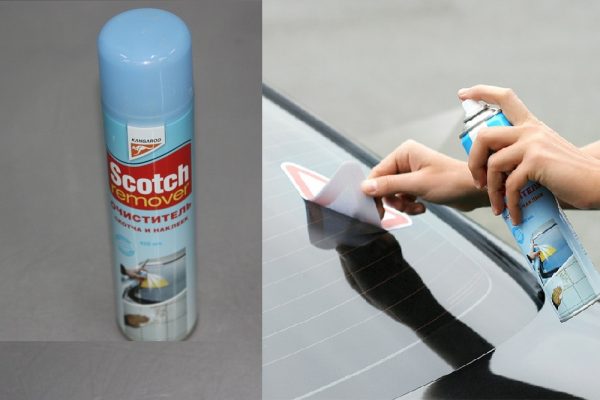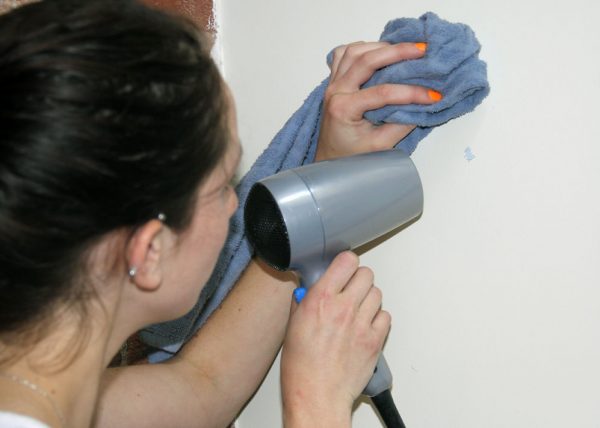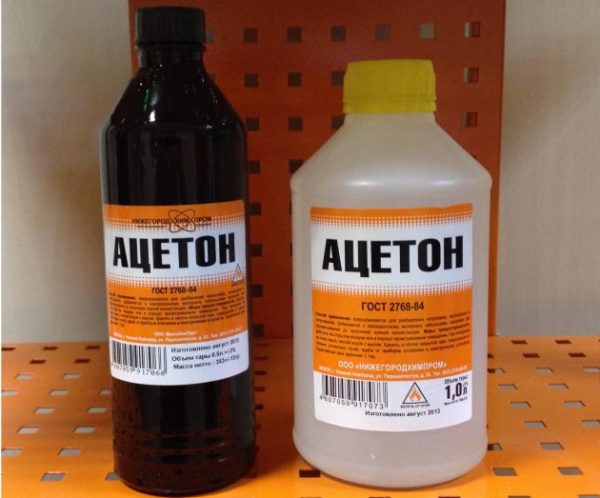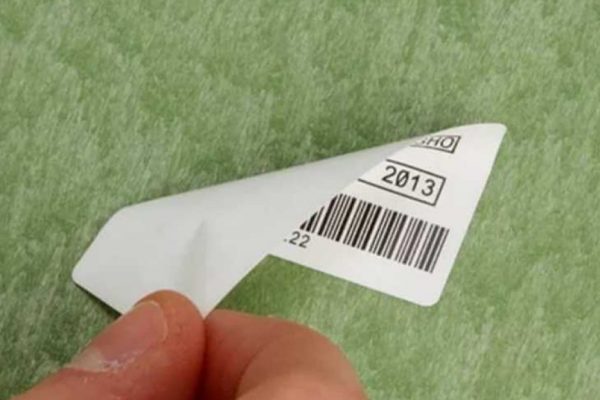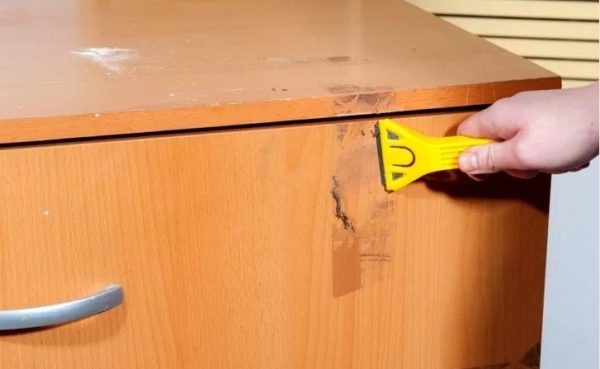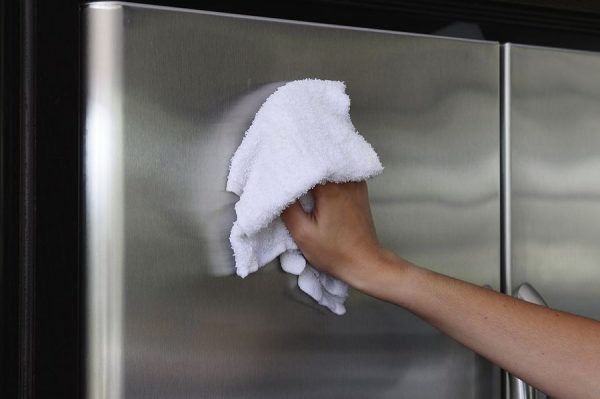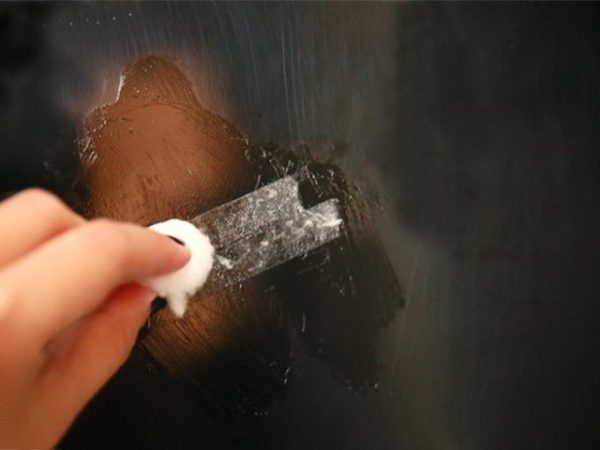Adhesive tape - transparent adhesive tape - is used everywhere. They can repair the chip on household appliances, attach a piece of linoleum, glue the broken thing. Despite the obvious benefits in everyday life, after scotch tape there are ugly marks, dirt, sticky stains that do not wear out well. How to wipe glue from adhesive tape? There are a number of proven methods by which it is completely possible to remove unsightly marks from any surface.
- Types of Adhesive Tape
- General rules for glue removal
- How to wash traces of tape and stickers: ways
- Tools at hand
- Chemical methods
- By heating
- Steam removal
- Solvent Removal
- Removing glue from stickers and tape depending on the surface
- clothing
- Plastic
- Glass
- Furniture
- Other surfaces
- Precautionary measures
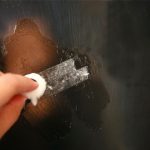
Types of Adhesive Tape
There are several varieties of scotch tape, but they all have one of two bases - acrylic or rubber. Depending on the appearance and scope of application, adhesive tapes based on acrylic are as follows:
- stationery tape - used for gluing books, paper, cardboard;
- packaging - transparent, but denser, used for packaging products in trade, industrial enterprises, in warehouses;
- color - has a certain color (usually matte white, black, green, bright yellow), is needed for marking boxes;
- ribbon with logos - it is used in advertising companies;
- double-sided - adhesive material on both sides;
- mounting rubber - required for fastening plexiglass sheets.
Types of rubber-based tapes are much smaller. Most often in stores there is a masking tape, which can be glued to any surface to protect them during repair, painting. Reinforced tape is also used, which is used to provide a waterproof surface.
to contents ↑General rules for glue removal
It is much easier to wash or wipe off traces of glue from the tape while they are fresh. Later, dust stains on the spots, they darken and dry out, it will be more difficult to wash them off. Perhaps it will not work out with improvised methods, you will have to buy solvents, special means for removing glue. Such substances can ruin delicate surfaces, and you need to try them first in an inconspicuous area.
to contents ↑If glue residues are found on fabric, furniture, clothing, it is better to wash them with products that do not leave greasy stains and do not corrode paint. Plastic and wood should not be affected by aggressive substances, because these materials are easily damaged.
How to wash traces of tape and stickers: ways
You can clean the surface of stains of adhesive tape in different ways, but the simplest is mechanical. It works especially well on fresh stickers, for example, immediately after tearing off the label from a new pan, bottle, can. It is necessary to rub the problem area with your fingers, rolling the glue with balls. Then the remaining dirt should be washed off with a hard washcloth with a dishwashing detergent, laundry soap. Small stains can be cleaned with wet wipes by simply wiping the base thoroughly.
to contents ↑Tools at hand
You can remove ugly spots with a variety of methods, for the implementation of which you do not need to go to the store:
- Eraser. A regular school eraser that erases pencil marks will perfectly remove sticky stains.It is important that the surface is completely dry. It is rubbed with an eraser as much as possible, usually the glue spools are quickly removed.
- Melamine sponge. The principle of removing stains from dishes, a refrigerator, other products is similar to the previous one, with the exception of preliminary wetting of the surface. After you need to rub the area with a sponge until the traces of glue disappear completely. It is important not to use the melamine sponge on the inside of the dishes, not to touch the products - it is toxic.
- Means for dishes. An effective method of cleaning clothes and fabrics is as follows: moisten a stain of adhesive tape with a gel-like substance, rub it hard with your hands, as with a regular wash. Rinse the product, wash the whole.
- Lemon. Cut a slice of fruit, rub the stain with it, squeezing the juice, leave for 2-3 minutes. After that you can remove the softened spools with a scraper and wash off the remaining dirt.
- Sunflower oil. It is considered safe for washing plastic products, polymers. It is necessary to moisten a cloth in oil, apply to the dirt from the adhesive tape, leave for 20 minutes. Then you can easily remove dirt and polish the surface with a clean cloth.
- Alcohol, vodka, vinegar. In such products additives and dyes should be completely absent, otherwise dark spots will remain on the product. Medical alcohol works best - it is the strongest. They moisten a cotton swab, wipe the glue. After 5 minutes, you can clean the surface or wash the item. It is forbidden to use alcohol, vinegar on colored plastic.
- Soda. It can be used to mechanically clean contaminated products. Soda is diluted with water to a thick slurry, applied to a sponge, rub the area with traces of adhesive tape. After the product is washed, polished with a dry cloth.
Fresh spots of adhesive tape can be removed with a new adhesive tape. It is better to use masking tape. A strip of adhesive tape is applied to the remainder of the glue, firmly pressed, then torn off with a sharp movement. The procedure is repeated until all contaminants are completely removed.
to contents ↑Chemical methods
A variety of products are sold in stores that easily remove adhesive stains. There is even a special anti-adhesive tape that resembles hairspray in shape. Shake the cylinder for 3-4 seconds, after which the substance is sprayed onto the contaminated surface. After 2 minutes, traces of glue are carefully removed from the product with a plastic, rubber spatula. The tool is suitable even for painted surfaces. You can buy it in construction and hardware stores, for example, in Leroy Merlin (Moscow and other cities).
Other high-quality compounds against adhesive stains from adhesive tape, stickers:
- Spray Mellerud. Able to remove even traces of double-sided tape, including polymer parts. The cloth is moistened with plenty of solution, it moistens the surface, after 7 minutes it is wiped clean. After the site must be washed and wiped dry.
- Cleaner Scotch-Weld aerosol cleaner. Washes off all types of adhesives, works on metal, plastic, glass. For stubborn stains, you will have to repeat the procedure several times.
- Scotch Remover. Consists of safe solvents, citrus oils and fatty acids. Qualitatively removes traces of stickers, does not harm even delicate surfaces. It will help to cope with stains from tar, tar, adhesive films and stickers.
- Liqui Moly. A special composition based on bronopol is a powerful cleaner of sticker traces. Designed primarily for the car and is sold in auto chemical stores.
- Fine Glass (Kangaroo). The product contains isopropyl alcohol and glycol ether, intended for cleaning glass, ceramic, plastic and metal substrates from glue.
By heating
Sometimes adhesive traces so eat into the plastic surface that even strong products do not help, and store compositions can leave whitened spots. Usually, the most persistent pollution remains after double-sided tape, which was immediately removed poorly (foam is present in it). In this case, contamination should be preliminarily softened by heating it. For this purpose, you can use steam from a steam generator or hot air from a building, ordinary hair dryer.
Keep the device at a distance of 20 cm from the surface, otherwise there is a risk of plastic melting (only a household hair dryer is safe in this regard). After 2-3 minutes, the adhesive tape stain softens, it can be scraped off with a rubber spatula. On painted substrates, this method is not used, since the paint can peel off, swell.
to contents ↑Steam removal
Some try to warm a contaminated surface with a lighter. This method is extremely undesirable and most often leads to the appearance of persistent "burn" spots, melting of the product. It is better to boil water, bring the place of contamination to the teapot spout, hold it for about a minute. After uniform heating of the area, traces of glue can be removed. Then you need to wash the base with soap.
Solvent Removal
As a solvent, you can take ordinary gasoline, refined kerosene or even ammonia. With the help of such liquids there is a chance to remove any stains from adhesive tape, stickers. But solvents can only be used on glass, ceramics, and similar materials; many of them act destructively on plastic. After applying the product, you need to wait a couple of minutes, then wipe the stain with a rag until clean. In addition to these, other solvents can be used:
- acetone;
- White Spirit;
- lighter fluid.
Often such methods are used by motorists: they remove labels from the glass of a car with gasoline, clean the glue on the headlights. At the end of the work, it is worth rinsing the glass with soapy water and clean water to remove stains. By the way, white spirit is safe for some types of plastic, as it is considered a mild solvent. In any case, even white spirit is not suitable for painted and polished substrates.
to contents ↑Removing glue from stickers and tape depending on the surface
Different materials react differently to the use of oils, improvised means or solvents, household chemicals. Therefore, it is worthwhile to clarify in advance whether this or that method will harm a particular surface.
clothing
Traces of stickers are sometimes found on hats, jackets, although manufacturers often prefer to use safe types of adhesives. The most popular tissue cleaning methods:
- Alcohol. You can moisten a cotton pad with alcohol, gently wipe the product, removing dirty traces. On strong, non-shedding fabrics, even acetone is used. Neither alcohol nor acetone is suitable for printed matter, for thin, delicate, woolen fabrics.
- Soap and powder. For starters, it is recommended that you simply wash your hands with the contaminated area using ordinary household chemicals. In many cases, this helps get rid of the problem.
- Washer. It is recommended to soak the product with detergent for an hour, then wash it in the machine in a suitable mode.
You can not use kerosene, oils, other fats and oil products on fabrics, the stains remaining after them will be even more difficult to remove.
to contents ↑Plastic
How to remove stickers from plastic is an important issue, because such products are widely used in everyday life, they often have glue residues (furniture, windows, toys, dishes, etc.). First, you need to evaluate the quality of the plastic: it is better not to use aggressive agents on thin material. The best methods for plastic:
- stationery eraser - you just need to wipe the dirt from the product, the method is good for household appliances, electronics, toys;
- solvents (vodka, alcohol, white spirit) - first you should check the effect of the liquid in a hidden area, there is a risk of whitish spots;
- heating - the stain can be heated with a household hairdryer, then carefully cleaned or washed with soap;
- masking tape - gluing the tape and sharply tearing it off with stains remains a good help.
to contents ↑
Glass
Glass products are usually the easiest to clean, because they do not deteriorate from chemicals. But delicate types of material can turn yellow, this sometimes happens with crystal. The following products are best suited for glue removal:
- acetone, nail polish remover;
- spray for washing windows;
- vodka and alcohol;
- vegetable oil;
- melamine sponge.
Furniture
Special furniture products — Vanish, Drop Vox, Help, and others — perfectly remove glue stains from the coverings of upholstered furniture and carpets.They are whipped into the foam, the place of contamination is lubricated, left for 20-30 minutes or longer (depending on the manufacturer's instructions). After the site you need to clean and rinse the foam. Upholstery can also be treated with vodka, making a preliminary test in a hidden area.
Glue is removed from the wooden surface of the furniture by such means:
- vegetable oils;
- baby massage oils;
- cream kitchen cleaners;
- erasers.
From the laminate, particleboard, MDF, glue residues are removed with soapy water, shaving foam, dishwashing detergent, then washed well with water.
to contents ↑Other surfaces
It is easiest to remove oil dirt from metal and alloy parts. The fatty acids present in it reduce the stickiness of the adhesive, change its properties, as a result of which it is easily removed. Apply oil for 15 minutes, applying a cotton pad or piece of cloth on top. Then the stain can be wiped off and the grease washed off with soap.
Painted metal can be carefully treated with vodka, alcohol. A stove and a refrigerator are often treated with apple cider vinegar, acetone - they will not harm the surface. It is allowed to erase traces of adhesive tape with dry cleaners, for example, Pemolux.
Other recommendations for cleaning different materials:
- tile, ceramics - acetone, alcohol, detergents;
- rubber - white spirit, solvent 646, Coca-Cola drink;
- mirrors - dry cloth, hot water, soap, window products;
- Wallpaper - heating with a hairdryer, applying fabric and “wetting” softened glue;
- surfaces with water-based paint - alcohol.
Precautionary measures
All work with aggressive chemistry should be carried out with gloves, protective clothing. It is important to provide fresh air to the room. When using the heating method, you need to work carefully so as not to get a burn. Before wiping stains from the electronics, it must be de-energized, while not abusing liquids and oils, so as not to spoil the device. The right actions will help return things to an attractive appearance at no additional cost.

